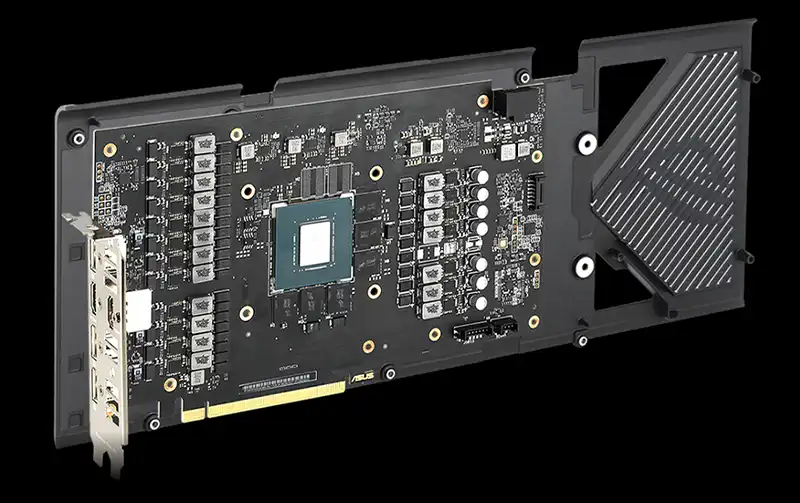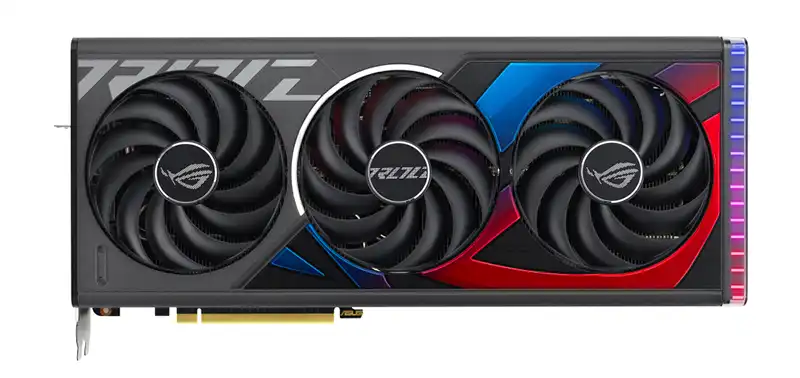You can also be interested in these:
- Asus ROG Strix B760-I Gaming WiFi motherboard review
- Asus ROG Hyperion GR701 gaming PC case: A premium choice for gamers
- Nvidia GeForce 8500GT review
- Intel Arc A750 graphics card review
Asus ROG Strix RTX 4070 Ti OC is the latest addition in Asus GPU portfolio, and it is a graphics card that will undoubtedly be high-end in every way, thanks to its impressive base performance and Asus’ optimization efforts. The Strix series features a massive semi-passive Axial Tech triple-fan heatsink with RGB lighting zones, along with a 2790 MHz boost to push performance beyond its competitors. Additionally, it boasts one of the best PCB and electronics in its series, with a 19-phase VRM.
Design of the GPU
The design of the ROG Strix 2022-2023 GPUs is impressive, with the Asus ROG Strix RTX 4070 Ti OC resembling the 4080 and 4090 versions, making it feel like having one of these beasts, at least in terms of appearance. This design necessitates an enormous 336mm-long heatsink that occupies 3.15 slots or, practically speaking, four. This size is excessive for the thermal needs of the card itself.

The construction and assembly process will be more complex than normal models, as the top cover will be an independent piece from the end cover and backplate, requiring an additional internal frame to hold the entire system. The top cover is constructed of aluminum with plastic inlays forming the brand’s logo in a blue-red gradient, delimiting the circles of the three fans.
The installed Axial Tech fans will be three 105mm-diameter units with high-density 11-blade fin design, connected with an outer stabilization ring. They have double ball bearing, alternate spinning system where the central fan spins in the opposite direction of the peripheral ones, and a semi-passive system that turns off the fans when the GPU is below 50ºC and turns them on when it goes above 55ºC.
The side areas are aesthetically well-designed, covering only the fan area and leaving the entire heatsink free to expel hot air. The visible part features the “Republic of Gamers” logo with AURA Sync lighting.

The end of the card is one of the most visually striking parts, with additional lighting integrated into its edge. The central part is filled with plastic grilles that integrate two 4-pin PWM headers to connect chassis fans, as well as three threaded holes for support.
Moving to the backplate, the aluminum design leaves the socket area visible to cool the filtering capacitors more effectively, with the usual hole at the end to increase airflow. The Dual BIOS switch is located on the front edge, allowing users to alternate between Performance and Quiet modes for the ventilation profile.
Ports and connectivity
Asus ROG Strix RTX 4070 Ti OC boasts an impressive panel of ports, surpassing its competitors in quantity with 3x DisplayPort 1.4a and 2x HDMI 2.1. While two HDMI ports are a significant improvement over one, it lacks the implementation of DisplayPort 2.1, which AMD has included in its RDNA 3 cards. Although currently unused, it is a way to ensure better support for the future.

Asus employs a PCIe 5.0 16-pin power header with ATX 3.0 certification, located approximately halfway down the side edge with excellent user access. The RTX 4070 Ti uses a PCIe 4.0 interface with its 16 active lanes.
Heatsinks
To access the PCB and heatsink, the user must remove the screws located on the backplate and panel of ports. However, due to an internal aluminum chassis, the heatsink cannot be completely opened. Still, the design of the heatsink can be observed, consisting of two large transverse aluminum fin blocks. While the block appears smaller than the volume supported by the cover, the size could have been optimized further.
The blocks are joined by six nickel-plated copper heat pipes originating from the cold plate, also made of polished nickel-coated copper, to evenly distribute heat across the rectangle. With 285W of TGP, the cold plate does not need to be a vapor chamber like those in the 4080 and 4090. The two main VRM zones are cooled by plates with silicone thermal pads, similar to those used by VRAM memory chips.
PCB and internal components
Asus ROG Strix RTX 4070 Ti OC, like other models of the brand, implements PCB through an automated process called Auto-Extreme that improves the precision and quality of soldering. The PCB will be common for the various variants of 4070 Ti, with varying VRM configurations and types of MOSFETS. In this case, it has a whopping 19 power phases using Infineon DrMOS converters specification A1253 H2149 E23U, along with high-performance metal-encapsulated choke coils and 15K capacitors.
TSMC’s AD104 4nm chipset boasts 60 Streaming Multiprocessors, which are divided into 60 3rd generation RT cores, 240 4th generation Tensor cores, and 7680 CUDA cores. The GPU has a fixed OC frequency of 2760 MHz but can run stably at 2850 MHz at maximum performance, almost reaching the maximum 3000 MHz that it can support. Additionally, it features dual AV1 NVENC encoders.

The VRAM is made up of 12 GB GDDR6X memory clocked at 10500 MHz or 21 Gbps effective, configured with six 2GB chips on a 192-bit bus. The same configuration as the upcoming 4070, but achieving a bandwidth of 504 GB/s. It still utilizes Micron chips with PAM4 operation technology that allows it to work with 2 bits per clock cycle instead of standard GDDR6, compatible with Resizable BAR.
Conclusion about the Asus ROG Strix RTX 4070 Ti OC
In terms of performance, the Asus ROG Strix RTX 4070 Ti OC is the epitome of what an RTX 4070 Ti can achieve. It outperforms other custom models and still has room for manual overclocking, consuming only 5W more than the stock version. It even performs better than higher-end models at 1080p and offers high performance at all resolutions.
Furthermore, the ROG Strix models of this generation boast the best aesthetics with their metal covers, increased RGB, and unique style. However, the oversized cooler could benefit from more compact measurements. On the other hand, it features the best PCB that a graphics card can have, with 19 well-optimized Infineon phases in consumption.
More stories like this
- Asus ROG Strix B760-I Gaming WiFi motherboard review
- Asus ROG Hyperion GR701 gaming PC case: A premium choice for gamers
- Nvidia GeForce 8500GT review
- Intel Arc A750 graphics card review
- All about the Intel Arc A380 GPU
